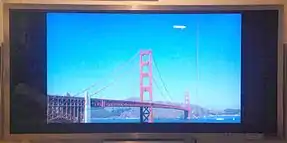21:9 aspect ratio
"21:9" ("twenty-one by nine") is a consumer electronics (CE) marketing term to describe the ultrawide aspect ratio of 64:27 (2.370:1), designed to show films recorded in CinemaScope and equivalent modern anamorphic formats. The main benefit of this screen aspect ratio, compared to the more common 16:9, is the absence of the black bars at the top and bottom of the screen when viewing content in this format, and a constant display height when displaying other content with a lesser aspect ratio.
The 64:27 aspect ratio of "21:9" is an extension of the existing video aspect ratios 4:3 (SDTV) and 16:9 (HDTV), as it is the third power of 4:3, where 16:9 of traditional HDTV is 4:3 squared. This allows electronic scalers and optical anamorphic lenses to use an easily implementable 4:3 (1.33:1) scaling factor.
SDTV
HDTV
"21:9"
The term "21:9" was chosen as a marketing term, first used by Philips in January 2009.[1] Due to its common denominator, 21:9 is more relatable to 16:9, the aspect ratio of regular HDTVs, rather than the correct 64:27 or 21:9. If it actually were 21:9 (2.33:1), the fraction could also be expressed in the reduced form as 7:3, relating to the 4:3 of standard-definition TVs.
As of 2017, this ratio is rarely used in TVs, due to it causing pillarboxing with standard 16:9 content.[2]
It is still prevalent in projection systems, using anamorphic lenses, and supported by a number of consumer electronics devices, including Blu-ray players and video scalers.
It is also used in computer monitors, where the term "21:9" can represent aspect ratios of 43:18 and 12:5 in addition to 64:27. The wider screen provides advantages in multitasking as well as a more immersive gaming experience.[3]
Constant image height
With content of different aspect ratios, adjustments have to be made when showing such content on a display with a fixed aspect ratio. To avoid loss of content (due to cropping) or distortions (due to stretching), horizontal or vertical bars of a uniform color, usually black to make them less noticeable, are added to adjust the image. With the black bars being unnoticed, this has the effect of a changing image image size when switching content aspect ratios.
A 21:9 display allows to present all content up to 'Scope aspect ratios at equal height, with changing vertical bars to the left and right of the image. Note how the large center circle, representing the main image area, remains at a constant size on the 21:9 display, while it changes on the other two depending on the aspect ratio of the content.

| 4:3 content | 16:9 content | 21:9 content | |
|---|---|---|---|
| 4:3 TV |
|
|
|
| 16:9 TV |
|
|
|
| 21:9 TV |
|
|
|
Motion picture film formats and 21:9
The "21:9" digital format's aspect ratio of approx. 2.37:1 is positioned between the classical CinemaScope aspect ratio (1678:715, approx. 2.35:1) and the aspect ratio of modern anamorphic cinematic content (1024:429, approx. 2.39:1), matching both with only a slight deviation.
Standardization
HDMI
As of May 2013, video timings in this 64:27 aspect ratio are supported by the technical specification that defines video timings for the HDMI interface, CTA 861-F:[4]
- 1280×720p, anamorphic pixel aspect ratio of 4:3
- 1680×720p, near-square pixel aspect ratio of 64:63
- 1920×1080p, anamorphic pixel aspect ratio of 4:3
- 2560×1080p, square pixel aspect ratio
- 3840×2160p, anamorphic pixel aspect ratio of 4:3
In November 2016, CTA (formerly CEA) published CTA-861-G[5] with these additional video timings in 64:27, as well as additional frame rates (48 Hz, 100/120 Hz UHD):
- 5120×2160p, square pixel aspect ratio
- 7680×4320p, anamorphic pixel aspect ratio of 4:3
- 10240×4320p, square pixel aspect ratio
All of the above timings are supported at frame rates of 23.97, 24, 25, 29.97, 30, 47.95, 48, 50, 59.94, 60, 100, 119.88 and 120 Hz.
Blu-ray
There was an effort, led by Panamorph, to add support for anamorphic video in a 21:9 aspect ratio to the Full HD, 3-D and Ultra HD Blu-ray specifications.[6][7] Eventually, this feature was not included in the final specification.[8][9] Given that Blu-ray Discs include the letterboxing on the image, this effectively means widescreen movies will be shown in a 16:9 space, with black bars on top and bottom. The company Folded Space, also initiated by Panamorph, was working on a proprietary solution, MFE,[10][11] to put anamorphic 21:9 video onto Blu-rays in a way compatible with standard players.
Advanced Blu-ray players, like the Oppo BDP-203/205, can be put into a 21:9 output mode.[12] In this mode, the player has the capability to extract the 21:9 center portion of the movie content of a letterboxed disc, while re-arranging the 16:9 menus and subtitles for 21:9.
Streaming services
Video streaming and download services use a proprietary technical infrastructure, and are not confined to the same strict rules about frame aspect ratios as standardized distribution services (such as broadcast and optical discs). They therefore often encode content as just the active frame, without any aspect ratio adjustment bars (letterbox or pillarbox bars). Movies with a 2.39:1 aspect ratio are a natural match for 21:9 output video timings, as long as the streaming clients support such video modes, and even content with other wide aspect ratios such as 2.00:1 and 2.20:1 are inherently maximizing the use of the output frame on such systems. Amazon Prime Video and YouTube support ultrawide movies/videos, while Tubi TV does not. Netflix has now added support for ultrawide displays when viewing via web browser for recent content.
Consumer devices
Flat panel TV
All Blu-ray Disc content with 1920 horizontal resolution has 1080 vertical resolution, though in the case of widescreen formats wider than 16:9, the image appears on 16:9 displays with letterboxing. Philips' "Cinema 21:9" TV eliminates the black bars by scaling the 1920 horizontal resolution to its full width of 2560 and the 800+ pixels of CinemaScope images (actual pixel counts vary)[13][14] is scaled to 1080 with the black space cropped. The result is an image which fills the screen, but does not provide higher quality due to the use of scaling.[15] Despite the intention being to fill the screen with a non-letterboxed image, the zoom mode can result in some cropping at the edges.[16] Content with the full image at 1920×1080 can be displayed in the center of the screen with pillarboxing, and should the viewer choose to not display CinemaScope content at full width, it appears windowboxed.
Philips
The Philips "Cinema 21:9" TV was the first LCD television of this aspect ratio.[17] The first model launched was a 56-inch screen size, although it was no taller than a conventional 16:9 42-inch television. Models released in 2010 and 2011 had screen sizes of 50 and 58 inches.
Early reviews claimed that it was "one of the coolest TVs" to enter the market for some time.[16] This set was previewed in the UK in advance of its release date of 18 June 2009. Pre-release launch events were held at numerous Philips retailers throughout June 2009.
The online advertising campaign surrounding the Cinema 21:9, titled Carousel, went on to win the most prestigious award in the advertising industry, the Grand Prix at the Cannes Lions International Advertising Festival.[18]
In 2012, Philips stopped production on all its 21:9 televisions due to lack of demand.[19]
Vizio
Vizio has since followed suit with their own Cinema TVs with identical resolution, similarly marketed as "21:9" in the United States.[20][21]
The 58-inch TV with a panel resolution of 2560×1080 has been sold in 2012 and 2013, and has since been discontinued. A planned 50-inch model never made it to market.
LG
LG has a number of monitors with panel resolutions of 2560x1080 (64:27), 3440x1440 (43:18), 3840x1600 (12:5) and 5120x2160 (64:27), the latest being advertised by LG as '5K2K' with a 21:9 aspect ratio.[22]
Other monitor manufacturers, such as Acer, AOC, Asus, BenQ, Dell,[23] HP, Iiyama, Lenovo, MSI, NEC, Philips, Samsung and Viewsonic, have since followed the suit.
At the CES 2014, LG presented the 105UC9,[24] a 105-inch curved LCD TV with a 5120×2160 panel, one of the first two ultrawide 5K screens. LG started selling the TV in early 2015 for approx. $100,000[25] in the U.S., the only ultrawide TV in the market that year.
Samsung
Also at CES 2014, Samsung presented a 105-inch curved LCD TV[26] with 5120×2160 resolution as well, the other first UW5K 21:9 screen.
BOE
Chinese panel manufacturer BOE presented an Ultra-Wide 10K 21:9 TV with a resolution of 10240x4320 (UW10K) at the 2015 Display Week conference.[27]
Front projection
Wide screen projectors with a 16:9 aspect ratio can be converted to 21:9 by attaching a 4/3 horizontal stretch or vertical squeeze anamorphic lens. This will optically scale standard projection images with e.g. 1920×1080 (FullHD) or 3840×2160 (UHD) to a 21:9 aspect ratio. These lenses are manufactured by optical companies like Isco and Zeiss, and provided to the home theater market by companies such as Panamorph.[28]
DIY anamorphic lenses have been made with 2 or 4 triangular prisms.[29]
Besides projectors outfitted with anamorphic lenses, Digital Projection,[30] Projection Design[31] and Avielo[32] have released projectors that utilise 2560x1080 pixels of a 2560×1440 DLP chip with a spherical lens.
Computer monitors
While not primarily intended for cinematic content, computer displays have also made use of this and other wide aspect ratios, marketed as "21:9", to provide expanded desktop space. Common resolutions in the market are listed below:
| Resolutions | Aspect ratio | |
|---|---|---|
| 2560×1080, 5120×2160, 7680×3240, 10240×4320 | 64:27 | 2.370 |
| 3440×1440, 5160×2160, 6880×2880 | 43:18 | 2.38 |
| 1920×800, 2880×1200, 3840×1600, 4320×1800, 5760×2400, 7680×3200, 8640×3600 | 12:5 | 2.4 |
Smartphones
Note: Technically 21:9 smartphones do not exist because smartphone screens are vertical. However, rotating a smartphone 90 degrees to landscape mode results in a horizontal ratio. 21:9 means that for 21 pixels in the horizontal axis, there are 9 in the vertical axis. 9:21, which is the correct term for smartphones, is the opposite (21 vertical, 9 horizontal).

On February 25, 2019, Sony launched their latest flagship device, the Xperia 1, with the world's first 21:9 ultra-wide 4K HDR-enabled OLED (6.5") display in a smartphone. They have trademarked the name CinemaWide for use in their latest ultra-wide Xperia devices.[33] It is not the first mobile device to use a 21:9 aspect ratio display; that recognition belongs to the LG New Chocolate, released in 2009. It has a 4" TFT display with a resolution of 345×800 pixels. The Samsung Galaxy Fold smartphone/tablet folding hybrid, with its 4.6" Super AMOLED cover display, and the Xperia 10 and 10 Plus are among the first modern devices with ultra-wide displays. Motorola introduced two 21:9 smartphones in 2019, the One Vision in May[34] and the One Action in August,[35] both with a 6.3" FHD+ IPS LCD screen.
Note that both Motorola and Sony chose to use a screen resolution of 2520×1080, rather than the CE resolution of 2560×1080, as defined in CTA-861. This leads to the device to have a "true" 21:9 (7:3) Aspect Ratio, rather than the normal CE aspect ratio of 64:27. The Xperia 1 also has an odd aspect ratio of 320:137, and would have been able to meet 64:27 with a more even resolution of 3840×1620. Sony does not adhere to consumer standards, as with their home theater projectors that feature a 4096×2160 4K resolution, rather than the CE resolution of 3840×2160.[36] 4096×2160 is a resolution only relevant in digital cinema (DCI), where movie theater projectors feature this resolution with either letterboxed 4096×1716 or pillarboxed 3996×2160 content for "Scope" (2.39:1) and "Flat" (1.85:1) aspect ratios, respectively. The full panel aspect ratio of 256:135 is unfit for normal consumer content with a 16:9 container aspect ratio.
| Device | Display specs and resolution | Pixel density | Screen-body ratio | Date announced | Notes |
|---|---|---|---|---|---|
| LG New Chocolate (BL40) | 4 inch HVGA TFT LCD (345 × 800) | 217 ppi | 57.7% | August 3, 2009 | |
| Sony Xperia 1 | 6.5 inch 4K HDR OLED (1644 × 3840) | 643 ppi | 82% | February 25, 2019 | |
| Sony Xperia 10 | 6.0 inch Full HD+ IPS LCD (1080 × 2520) | 457 ppi | 79.3% | ||
| Sony Xperia 10 Plus | 6.5 inch Full HD+ IPS LCD (1080 × 2520) | 422 ppi | 81% | ||
| Sony Xperia 5 | 6.1 inch Full HD+ HDR OLED (1080 × 2520) | 449 ppi | 80.9% | September 5, 2019 | |
| Sony Xperia L4 | 6.2 inch HD+ IPS LCD (720 × 1680) | 295 ppi | 79.5% | February 20, 2020 | |
| Sony Xperia 10 II | 6.0 inch Full HD+ OLED (1080 × 2520) | 457 ppi | 77.6% | February 24, 2020 | |
| Sony Xperia 1 II | 6.5 inch 4K HDR OLED (1644 × 3840) | 643 ppi | 84% | ||
| Sony Xperia Pro | 76% | ||||
| Sony Xperia 5 II | 6.1 inch 120 Hz Full HD+ HDR OLED (1080 × 2520) | 449 ppi | 80.9% | September 17, 2020 | |
| Motorola One Vision | 6.3 inch Full HD+ LTPS IPS LCD (1080 × 2520) | 435 ppi | 82.5% | May 15, 2019 | |
| Motorola One Action | August 15, 2019 | ||||
| Motorola One 5G | 6.7 inch 90 Hz Full HD+ HDR LTPS IPS LCD (1080 × 2520) | 409 ppi | 84.3% | August 31, 2020 | |
| Motorola Razr (2020) | 6.2 inch HD+ P-OLED (876 × 2142) | 373 ppi | 70.7% | November 14, 2019 | Internal display only, actual aspect ratio is 22:9 |
| Motorola Edge S | 6.7 inch 90 Hz Full HD+ IPS LCD (1080 × 2520) | 409 ppi | 84.1% | January 26, 2021 | |
| Samsung Galaxy Fold | 4.6 inch HD+ Super AMOLED (720 × 1680) | 397 ppi | 48.8% | February 20, 2019 | External display only |
| Samsung Galaxy Z Flip | 6.7 inch Full HD+ Dynamic AMOLED (1080 × 2636) | 425 ppi | 82.4% | February 11, 2020 | Internal display only, actual aspect ratio is 22:9 |
| Samsung Galaxy Z Fold 2 | 6.2 inch HD+ Super AMOLED (816 × 2260) | 386 ppi | 73.2% | August 5, 2020 | External display only, actual aspect ratio is 25:9 |
See also
References
- "Cinematic Viewing Experience". Archived from the original on 2009-01-18. Retrieved 2019-03-13.
- Demers, Cedric; Azzabi, Mehdi (15 June 2017). "What is the Aspect Ratio?". Rtings.com. Retrieved 2019-02-02.
- Simmons, Adam (14 April 2016). "The 21:9 (2560 x 1080) Experience". PCMonitors.info. Retrieved 2019-02-02.
- "Research & Standards - DTV Interface". Retrieved 2019-07-16.
- "A DTV Profile for Uncompressed High Speed Digital Interfaces (CTA-861-G)". Retrieved 2019-07-16.
- "Anamorphic encoded Blu-Rays on the Horizon !". 2012-11-01. Retrieved 2020-07-30.
- "Anamorphic encoded Blu-Rays on the Horizon !". 2014-01-21. Retrieved 2020-07-30.
- "Anamorphic encoded Blu-Rays on the Horizon !". 2015-01-29. Retrieved 2020-07-30.
- Blu-ray Format Extension Video Characteristics
- "Folded Space Announces Blu-ray Disc® Encoding Technology Providing up to 50% Greater Performance for Movies with Panoramic Aspect Ratios". 2012-05-17. Retrieved 2019-05-21.
- "Folded Space – UltraWide Cinema by Panamorph". Archived from the original on 2015-02-21. Retrieved 2015-03-02.
- "OPPO UDP-20X 4K UHD Blu-ray Disc Player Firmware Update". Retrieved 2019-03-13.
- "Native 2.35:1 Projector Unveiled By avielo optix". Home Theater Review. Luxury Publishing Group. 13 September 2010. Retrieved 2019-02-02.
- Hollington, Jesse (18 February 2008). "The Complete Guide to iTunes Movie Rentals, Part 2". iLounge. Retrieved 2019-02-02.
- Lheur, Vincent (3 July 2009). "Philips 56PFL9954H". DigitalVersus. Archived from the original on 2010-07-23.
- "Philips Cinema 21:9 56PFL9954H review". What Hi-Fi?. Future Publishing. 7 July 2009. Retrieved 2019-02-02.
- "Philips launches World's First Cinema Proportion Full HD 3D LED Pro TV with Ambilight". Archived from the original on 2013-01-04. Retrieved 2011-02-01.
- "Film Grand Prix for Carousel". Shots. Media Business Insight. 27 June 2009. Retrieved 2009-09-22.
- Goddard, Louis (28 August 2012). "Philips discontinuing super-wide Cinema 21:9 TVs due to lack of demand". The Verge. Vox Media. Retrieved 2013-03-18.
- Miller, Paul (4 January 2011). "Vizio bringing 21:9 Cinema HDTV to CES with 2560 x 1080 resolution, all our hopes and dreams". Engadget. Verizon Media. Retrieved 2019-02-02.
- "VIZIO Unveils Ultra-Widescreen 21:9 Cinemawide HDTV LED LCDs for the Ultimate Cinematic Experience". Vizio. 5 January 2011. Archived from the original on 2011-07-17. Retrieved 2019-02-02.
- "21:9 UltraWide® Monitors". LG. Retrieved 2019-02-02.
- Muller, Sasha (19 February 2013). "Dell UltraSharp U2913WM review". Alphr. Dennis Publishing. Retrieved 2019-02-02.
- Lai, Richard (18 December 2013). "LG's 105-inch, 21:9 curved UHD TV is wide enough to be a tanning bed". Engadget. Verizon Media. Retrieved 2019-02-02.
- "LG 105UC9: 105 Class (104.6 Diagonal) UHD 4K Smart 3D Curved LED TV w/ webOS™". LG USA. Retrieved 2019-02-02.
- Lawler, Richard (19 December 2013). "Samsung has its own 105-inch, ultrawidescreen UHD TV to show at CES". Engadget. Verizon Media. Retrieved 2019-02-02.
- Larsen, Rasmus (5 June 2015). "TV with 10K resolution exhibited by Chinese BOE". FlatpanelsHD. Retrieved 2019-02-02.
- "Panamorph UltraWide Home Theater Projector Lenses". Retrieved 2019-07-16.
- AVS Forum: Just got my French Prisms
- "dVision Scope 1080p". Digital Projection. Archived from the original on 2013-06-07. Retrieved 2019-02-02.
- "F35 series". Projection Design. Archived from the original on 2011-06-09. Retrieved 2019-02-02.
- "optix superWide235". Avielo. Archived from the original on 2011-03-04. Retrieved 2019-02-02.
- Ricky (6 February 2019). "Sony trademarks "CinemaWide" display for Xperia XZ4". GSMArena.
- Welch, Chris (15 May 2019). "The Motorola One Vision has a 21:9 screen and looks less like an iPhone clone". The Verge. Retrieved 15 May 2019.
- "The Motorola One Action unveiled with an ultrawide camera, 21:9 screen". GSMArena. 15 August 2019. Retrieved 1 December 2019.
- "Home Theater Projectors".









.svg.png.webp)